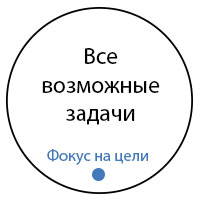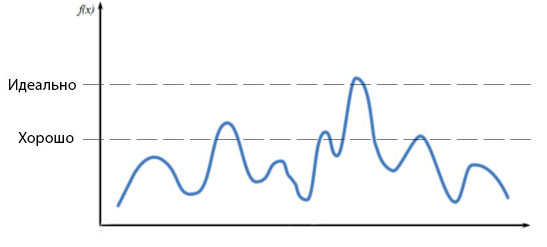There are about 100 trillion synapses and tens of billions of neurons in our brains. The exchange of information occurs, according to neurophysiologists, at about 200 Hz in active mode.
We consider: bits. Considering that a neuron is not one arithmetic operation, but a kind of microprocessor, we get that we have apetaflops supercomputer“on board”. And there is an opinion that it is alsoexascale.
As powerful as it is, resources are limited. Furthermore…
Most of the time, our “supercomputer” is busy with the “calculations” of social interaction.Speech, hearing, sight, touch, sensation, emotion, empathy ...
"Oh! What went! "," Oh! He looked askance at me! "," What you were - so you remain. "
This is neither good nor bad. This is normal!
Of course, there are deviations, but basically it is.
In order to successfully solve a certain task or problem, you need to focus on it. Set clear goals. Stop distracting, procrastinating.
Or just ignore it (the problem) and do ... nothing.
Our brain, in fact, doesn’t care: watch movies, play games or design a spaceship.

What goal setting and focus gives:
- limiting the search area and reducing the combinatorial skills of possible solutions ( in the elderberry garden, and in Kiev, the uncle )
- () ( !)
- , (-)
- , , , ( ).
"The end justifies the means." The converse statement is rather false.
Ambition is great! You can dream - great! “But the neighbor ...”
But it is impossible to fly to the moon on a bicycle. You cannot reach America on foot. Bananas do not grow on the apple tree.
Going on a long journey, conduct an audit in the garage. Maybe you don't have a car there. Maybe ... the garage itself. As a result, the “long journey” will be a half-hour trip to the store.
The target or target vector can be easily described mathematically. It is a list of parameters and their values (specific or range).
For example: height-100mm, width-50mm, weight-0.5kg, speed-3m / s, number of legs-from 3 to 4 pcs.
The size of the list can also vary.
The choice of the target vector, of course, depends on the resources available and planned in the future. The goal “Build a roof in 10 days” does not make much sense if there are no walls, but only the foundation. And if there is, please.
It makes no sense to include the parameter “Optimal feeding time for a cat” in the target vector if you don't have one (a cat), just like “Amount of water for watering tomatoes” if there is no summer cottage.
It is impossible to make a robot with dimensions of 50x50x50mm if you have only Raspberry Pi as a “brain”.
This is actually great! This limits the scope of the search. Focuses on the decision, which already "prompts" life, and does not drive into some semblance of schizophrenia "Maybe ...", "And if ...".
Innovation is good - the main thing is not to spend the entire family budget on creating an advanced racing supercar.

Setting the threshold of the objective function, which expresses a certain amount - the convolution of a multidimensional target vector.
When the parameters of the target are clearly defined, the process of aiming, pointing or focusing is a matter of technology. Moving forward (the thought process) is carried out by laying a route (searching for neural connections) with holding the target “in the sight”, discarding options that do not lead to the goal.
Also, walking along new "paths", creating new routes, connections between neurons or their analogs in the scheme is not excluded.
Flow
Have you noticed when you immerse yourself in the work process, then you do not really like when distracted?
This happens because all the "capacities" are occupied, and the process of social interaction is lowered in priority. Of course, you can switch, but it takes some time. Plus, on top of everything else, the notorious Flow , which is so difficult to achieve , is lost .
Thinkers, scientists, programmers generally love solitude - thus, unnecessary information is cut off.
The flow in the information system will be the process of calculations.
No power outages, stops, algorithm pauses and no interruptions in communication.
Otherwise, you can interrupt the process at a time close to finding a solution. The results will show that there is no solution, the model is probably wrong and valuable time will be lost.
Finding a solution
Just because a decision comes to our mind does not mean that the brain immediately forms them. Going bust variants enormous proportions. Often problems are not solved for years and even centuries. Focus + combinatorics. New technologies appear - the functional basis is expanded.
Many people involved in solving the same problems go to the goal in different ways. If a solution is found, then not all. It is also true that different people come to similar solutions and even to ... the same.
If we take it for a postulate that the search for a solution is an absolutely random process and all empirical methods are just ridiculous excuses for scientific "activity", then a clear goal and focus on it, at least, shows where we are going and the fact of arriving at the destination.

Time . Also, if we think in terms of goals, then we designate a reasonable time period for their achievements. Usually we work it out by itself, at least for simple tasks like: "Go to the store", "Hang the chandelier", "Brush your teeth."
We don't do this for a week, do we?
Time is a very convenient parameter for determining such properties as: the power of the computing system, the achievability of the goal with existing resources, the correctness of the chosen model for calculations.
We can even do this trick - calculate 10% of the allotted time on 10 different computing architectures and see, with a high degree of probability, the best system for a given task.
Why? Because one architecture may not reach the goal and close.
"This is a failure, Karl!"
Accuracy . It’s probably right to talk about the error of hitting the target. If our target vector is expressed in clear numerical parameters, then we can also evaluate the result.
Percentage accuracy can be defined as: . This is an option.
Perfectionism is not about achieving a goal. Do not forget about it. This is not about traffic. This is about the accuracy of hitting the target, proximity to the target coordinates. Otherwise, we will spend too much time and other valuable resources, but we will not reach the parameters of the system that we need.

By raising the bar high, we risk breaking our neck.
And, as practice shows, the battle for every percentage after 80% accuracy complicates the system by an order of magnitude. After 95% accuracy, the conversation is already about fractions of a percent.
The reverse side of the focus is the local optimum . We usually break the problem down and solve it piece by piece. This is a technique. She works. But, achieving the necessary parameters of a separate module, we will not be able to achieve the optimal parameters of the system as a whole.
A vivid example: departments of an enterprise. They all have different and rather conflicting goals. And if the director does not competently regulate them, then we will get the result as in the fable "Swan, Pike and Cancer".

Local optimum as a result of the operation of modules working only for private purposes.
Balance. All of the above concepts must be properly balanced. Everything is good in moderation. The priorities of goals are set, which are constantly changing. This is normal.
If you want to live, be able to spin!
If we ourselves do not set goals for ourselves, then the outside World does it for us.
Many say: “This is karma!” When they constantly fall into the same situations. But if you develop an algorithm of behavior in them, solve the problem, the problem usually "goes away". A new problem appears and the cycle repeats.
Mistakes, frustration - "brain explosion" and urgent restructuring.
Above all, setting and achieving goals takes place inside the brain on a constant small scale. They themselves arise as a result of his activities. Thus, the state of the neural network is optimized.
Motivation
Our motivation is associated with emotions, which in fact are the total energy of our neural network, the frequency of the brain, the sensations that various hormones and neurotransmitters give. But the external environment, which constantly kicks us, is of decisive importance here.

The stronger the impact (motive), the more the focus shifts there, the resources are mobilized to solve the problem with the highest priority. An example would be dodging a ball flying at you while on the phone. The conversation is most likely interrupted.
Motivation can also be internal - some abstract problem haunts you. You constantly think about it, look for ways to solve it. Sometimes such thoughts turn into mania, and real needs fade into the background.Fans of sports and rock bands often pound each other, proving that their idols are the best. Girls don't like their curly hair, guys don't like their ... biceps size.
The motivation for AI is as follows: we supply a huge set of data to the input of the ANN and achieve the maximum of the objective function - compliance with the output data obtained and verified as a result of the mental activity of people.
In fact, we give external motivation. We make the processor and peripherals learn, work.
It works! True, this approach does not lead to the creation of something new.
If the result does not suit us, we change the target parameters and (or) retrain. AI remains impassive.
Passions and emotions appear when there is freedom of choice.
The choice of goals and the way to achieve them.
Experience is also a source of emotions, it determines the maximum energy, an emotional response to that sphere (a set of images, a tensor) that a biological or silicon brain constantly deals with .
A professional is focused on his field of activity: a doctor heals, an engineer designs devices, a clown entertains people.
Between any areas there is an intersection, general patterns, methods for achieving a result.
Everything is interconnected, so we walk in a circle. But if we have a goal, we always know where to go.
That's the whole trick!